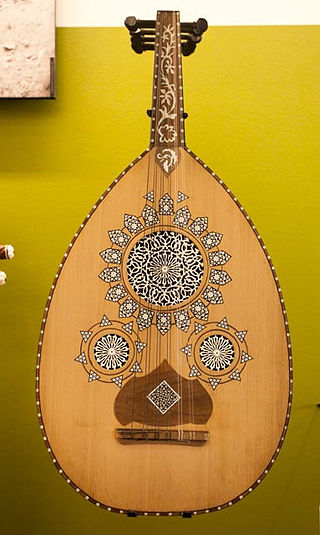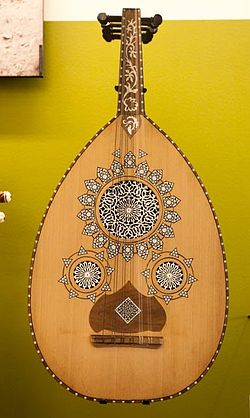ਊਦ
From Wikipedia, the free encyclopedia
Remove ads
ਊਦ (/ˈuːd/; ਅਰਬੀ: عود ʿūd, ਬਹੁਵਚਨ أعواد, a‘wād; ਅਰਮੀਨੀਆਈ: ուդ, ਅਸੀਰੀ:ܥܘܕ ūd, ਯੂਨਾਨੀ: ούτι; ਇਬਰਾਨੀ: עוּד; ਫ਼ਾਰਸੀ: بربط ਬਰਬਤ; ਕੁਰਦੀ: [ûd] Error: {{Lang}}: text has italic markup (help); [ud or ut] Error: {{Lang-xx}}: text has italic markup (help);[1] ਅਜ਼ੇਰੀ: ud; ਸੋਮਾਲੀ: [cuud] Error: {{Lang}}: text has italic markup (help) ਜਾਂ ਕਬਾਨ) ਇੱਕ ਨਾਸ਼ਪਾਤੀ ਵਰਗਾ ਤੰਤੀ (ਤਾਰਾਂ ਵਾਲੇ) ਸੰਗੀਤ ਸਾਜ਼ ਨੂੰ ਕਹਿੰਦੇ ਹਨ ਜੋ ਅਰਬੀ, ਇਬਰਾਨੀ (ਯਹੂਦੀ), ਯੂਨਾਨੀ, ਤੁਰਕੀ, ਉੱਤਰ ਅਫਰੀਕੀ ਅਤੇ ਉਸ ਦੇ ਆਸਪਾਸ ਦੇ ਹੋਰ ਖੇਤਰਾਂ ਦੇ ਸੰਗੀਤ ਵਿੱਚ ਪ੍ਰਯੋਗ ਹੁੰਦਾ ਹੈ। ਇਸ ਵਿੱਚ ਪਰਦੇ (ਫਰੇਟ) ਨਹੀਂ ਹੁੰਦੇ ਅਤੇ ਇਸ ਦਾ ਤਾਣਾ ਬਹੁਤ ਪਤਲਾ ਅਤੇ ਛੋਟਾ ਹੁੰਦਾ ਹੈ। ਕੁੱਝ ਸੰਗੀਤਕਾਰ ਇਸਨੂੰ ਆਧੁਨਿਕ ਗਟਾਰ ਦਾ ਪੂਰਵਜ ਯੰਤਰ ਮੰਨਦੇ ਹਨ।[2]
Remove ads
ਹਵਾਲੇ
Wikiwand - on
Seamless Wikipedia browsing. On steroids.
Remove ads

